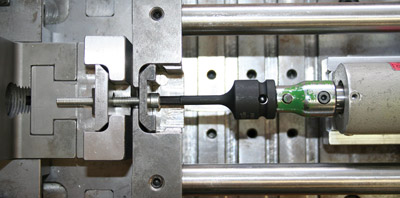

NORMA Group manufactures a wide range of joining technology solutions, including clamps installed in the cooling water systems of motor vehicles. Such components perform a critical function, even if they are relatively inexpensive as a share of the total cost of the vehicle. If one of these hose clamps fails, the cooling water hose can leak and slip off. In that case the coolant would escape and the vehicle would no longer be functional. The damage would be large in comparison with the relatively small component.
In conjunction with a series of research projects conducted by university students, a new test stand has been developed that NORMA Group can use to analyse screwed connections in order to ensure product reliability.
Measuring and testing under realistic conditions
Screws are used in nearly all of the products manufactured by NORMA Group: in exhaust system couplings, charged air connections, cooling water systems, etc. When a clamp is installed, tightening the screw generates tension, which fastens a hose to the end of a pipe, for example. The new test stand enables NORMA Group’s engineers to measure and study the principle of converting torque into tension under realistic conditions. With conventional hose clamps – such as the ones on garden hoses – these test methods have already been standard practice for many years. Now the new test stand also makes it possible to conduct analyses under realistic conditions (with high preload forces) to study profile clamps, high-pressure couplings, and exhaust system connections, all of which are used in motor vehicles, ships or aircraft. NORMA Group has used the experience it has acquired over the years, with the knowledge it has gained from other component applications, in order to perfect this state of the art test stand. Moreover, components today must also withstand greater stresses and comply with tighter production tolerances than ever before.
Test stand simulates ‘soft tightening’
NORMA Group points out that generally speaking, typical screw test stands do not consider all of the critical parameters. When a hose clamp is being installed, it is first positioned over the hose. Then the screw must be turned a few times in order to generate the required tension, because the hose is compressed in the process of tightening the clamp. As a consequence, the number of turns until the clamp is secured is many times more than when turning a lug nut, for example. The new test stand is able to simulate that ‘soft tightening’.
Standardised testing shortens development times
In order to ensure that products have been thoroughly investigated prior to market launch, NORMA Group has adopted this testing as a standard practice along the path to developing a new component. Over the course of the product development cycle it ranges from simple functional verification and additional functional testing all the way to comprehensive functional endurance tests. NORMA Group starts with simple test methods and proceeds to prolonged, complex testing procedures, thereby following the path of a product’s development. This – and also the fact that the testing is now conducted in-house – shortens the total time it takes NORMA to develop a new product.
www.normagroup.com

Having spent a decade in the fastener industry experiencing every facet – from steel mills, fastener manufacturers, wholesalers, distributors, as well as machinery builders and plating + coating companies, Claire has developed an in-depth knowledge of all things fasteners.
Alongside visiting numerous companies, exhibitions and conferences around the world, Claire has also interviewed high profile figures – focusing on key topics impacting the sector and making sure readers stay up to date with the latest developments within the industry.
Don't have an account? Sign Up
Signing up to FastFixTechnology.com enables you to manage your account details.